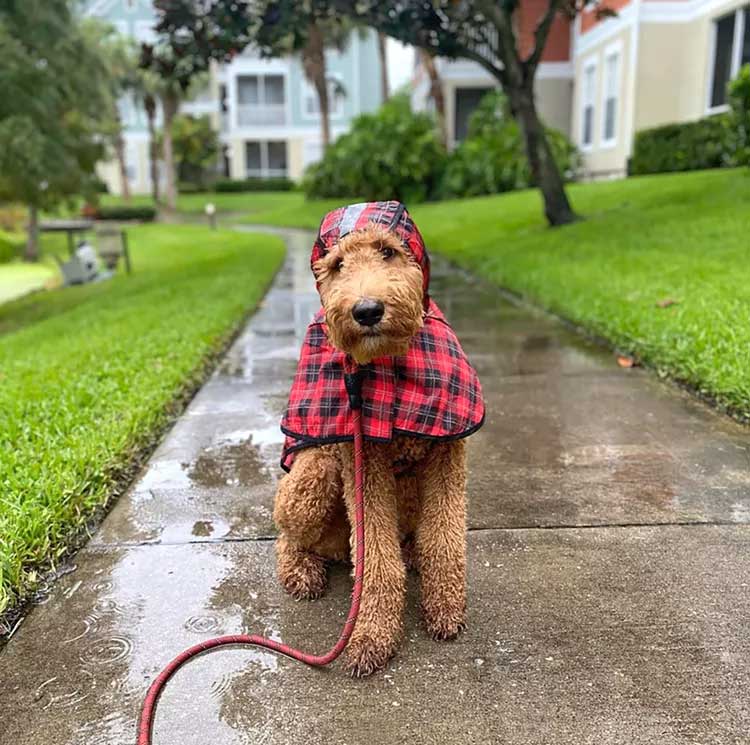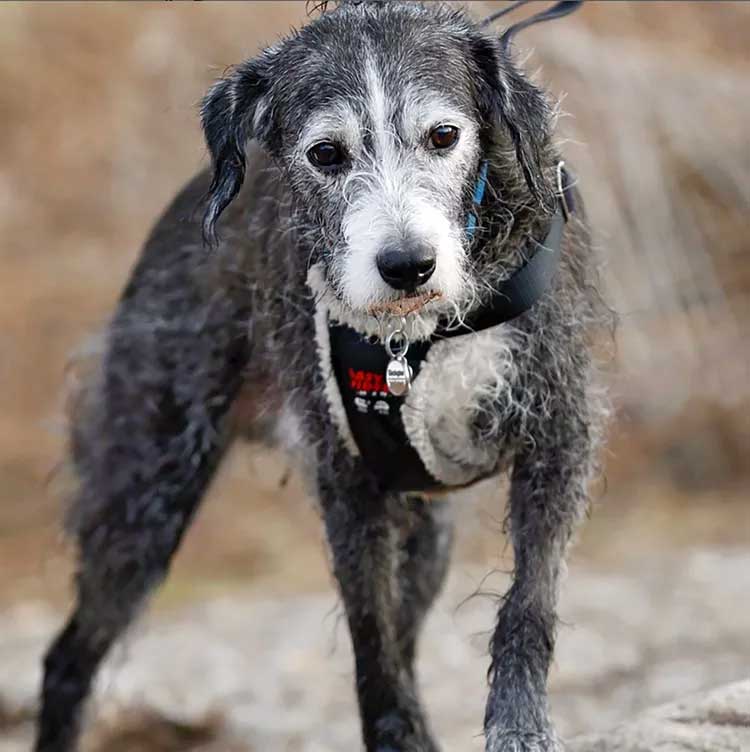The adorably playful boxerdoodle is a rare, fairly new crossbreed that can range from small to large in size. This boxer and poodle mix makes a delightful addition to all kinds of families.

Boxerdoodle Overview
| OFFICIAL NAME | Boxerdoodle |
| COMMON NAME | Boxerdoodle |
| PET HEIGHT | 10 to 25 inches |
| PET WEIGHT | 12 to 70 pounds |
| LIFESPAN | 10 to 12 years |
| GOOD WITH | cats, children, dogs, families |
| TEMPERAMENT | friendly, playful |
| INTELLIGENCE | high |
| SHEDDING AMOUNT | infrequent |
| EXERCISE NEEDS | high |
| ENERGY LEVEL | active |
| VOCAL LEVEL | when necessary |
| DROOL AMOUNT | medium |
| BREED GROUP | hybrid |
| BREED SIZE | medium (26-60 lbs.) |
| COAT LENGTH | curly, medium, short |
| COLORS | black, blue, brown / chocolate / liver, cream, fawn, gold / yellow, gray, red, white |
| PATTERNS | bicolor, brindle |
| OTHER TRAITS | easy to train, good for first-time pet owners, good hiking companion, hypoallergenic, loves water, prone to health issues, requires lots of grooming, strong loyalty tendencies |
Boxerdoodles are a fairly rare—and incredibly cute—hybrid dog breed that tend to be bright, energetic, and friendly, although they might be aloof around new people. This boxer and poodle mix, which is also sometimes referred to as a "boxerpoo," is most often medium to large in size, but can be found in a wide array of sizes and colors due to her poodle parentage.
A joy to train, a boxerdoodle is likely to be entirely eager to please, making her a fabulous addition to most families—first-time dog owners included. But her energetic nature, paired with the fact that boxers have a Tigger-like tendency to bounce, might make her a challenge around small children or seniors.
Appearance
As a boxer and poodle mix, boxerdoodles can range in appearance, especially when it comes to size if they have toy or miniature poodle rather than standard poodle roots. However, more often than not, boxerdoodles land in the medium-to-large range since (for reasons that are probably obvious) a boxer is a little more likely to mix with a standard poodle than with the smaller poodle varieties.
Size isn't the only thing that differs about a boxerdoodle's look. For one, she can end up with a longer poodle snout or the sturdy boxer jaw. But you'll typically see her with a more poodle-like tail.
Poodles come in lots of different colors, so it's possible for the boxerdoodle coat to come in just about every hue, including bicolor and brindle patterns. A boxerdoodle's fur often ends up somewhere in between their boxer parent's short, sleek coat and her poodle parent's curls, sometimes looking similar to what you'd see on a schnauzer. These pups require frequent brushing to remain free of tangles, and if your boxerdoodle takes closely after her poodle side, she'll need even more grooming and upkeep.
Poodles are considered to be "hypoallergenic" dogs, even though there's really no such thing as a truly allergen-free pet. This means a boxerdoodle can be low-shedding and might be a good fit for people with allergies. But before bringing home a boxerdoodle puppy, spend time with the breed to see how your allergies react.
Temperament
Both boxers and poodles are popular dog breeds, but what happens when you put them together? "With this combo, you could expect a smart, high-energy dog who is eager to learn and generally friendly, though they may be slightly aloof to new people," says Erin Askeland, CPDT-KA, CBCC-KA, Camp Bow Wow's Animal Health and Behavior Consultant.With two parent breeds known for their playful, athletic natures, you may have a bit of a clown on your hands—which can make boxerdoodles delightful additions to many homes. They're especially well-suited to a family that loves to hike on the weekends or that has children who love to play (these dogs need a fair amount of daily exercise!).

But because this is a rare and relatively new mixed breed, there's not much in the way of consistency among boxerdoodles. It's important to be prepared to train and socialize your puppy from the moment you bring her home. Some boxerdoodles may be outgoing and friendly to everyone, while some will be loyal to their families but more standoffish with strangers and in new places.
"Because of this combo's eagerness to please, [reward-based] training early and often is ideal for all family members," Askeland says. "Since they can be aloof at first with new people, a puppy socialization class and additional group training can help them get used to other dogs, people, and environments early on to help them learn how to cope well when facing new situations in the future."
Boxerdoodles can be sensitive, making positive reinforcement training a must. And because she's so darn bright, you may find you need to work hard to stay ahead of her by teaching her new tricks and changing up her routine. It'll all be worth it in the end, though, because the more you engage her curious mind, the happier this dog will be.
Living Needs
Both parent breeds are known for having particularly goofy puppy-stage antics, and although boxers and poodles generally calm down by their second or third birthdays, you can still expect boxerdoodles to benefit from plenty of activity as they age."This hybrid is likely to result in a larger dog … with high energy that requires daily exercise; these are not couch potato dogs!" Askeland says. "Long walks, hikes, runs, and playtime can help keep them happy and healthy and fulfill their needs. With this, they are more likely to relax in the home when it's time to settle down."

Thanks to their poodle side, boxerdoodles might love swimming and retrieving. And thanks to their boxer genes, it's entirely likely they'll be rather bouncy, too. A home with a securely fenced backyard is ideal, but, depending on just how high-energy your boxerdoodle is, she might also live happily in an apartment with regular exercise.
It's difficult to know which personality traits are most likely to come through in a new crossbreed like the boxerdoodle. But it's worth noting that boxers don't do well when left alone for long periods of time, and poodles, too, can develop separation anxiety. So this is not a furry friend you should leave alone all day, every day. If they become bored or lonely, they'll find a way to let you know—and chances are good that you won't be thrilled.
With proper introduction, boxerdoodles are usually accepting of other four-legged siblings. Essentially, they'll fit right into any home where they get ample exercise.
Care
With newer hybrids like the boxerdoodle, it's challenging, if not impossible, to know exactly what you're getting. And that's certainly true when it comes to preparing for their grooming needs.If your boxerdoodle ends up with a wavy or curly coat, she likely won't shed much and might be better for people with dog allergies—but you'll also have to take her for regular grooming appointments. If her coat is shorter and straighter, you might not need to get to the groomer, but you'll probably end up with a little more hair on your furniture and floor.

Regardless of her coat, brushing her every day will help reduce tangles and keep shedding under control. And like every dog, brushing those chompers will help your boxerdoodle stay healthy (and kissable). Every month or so, trim their nails, clean and check their ears for any signs of infection, and give them a bath as needed. If your boxerdoodle has deep facial folds (like a purebred boxer) keep those clean, too, using a damp washcloth and ensuring the skin dries out afterward.
Health
The boxerdoodle generally has a lifespan of 10–12 years, but the official breed clubs for both boxers and poodles have long lists of recommended health tests and potential health issues. Boxerdoodle pet parents need to know what health concerns are possible—and be aware of the symptoms.Like bulldogs and pugs, boxers are brachycephalic, which means they're prone to airway issues and upper airway obstruction, says Yui Shapard, BVM&S, MRCVS, educational director for the Association of Asian Veterinary Medical Professionals. But mixing them with a breed that doesn't have that issue—like the standard poodle—can offset that risk, which can be a positive, she says.
Still, she says, "Standard poodles are a poster child for Addison's disease and certainly for gastric dilation volvulus [also known as bloat or GDV] as well," which are both potentially life-threatening if not immediately addressed.
Addison's, she notes, has particularly vague signs (lethargy, vomiting, and diarrhea)—so much so that it's called "the big masker" in the veterinary world—and it requires several different tests for diagnosis. "It's tremendously helpful when owners are aware of these steps so that we can assess as swiftly as possible and begin the process of treatment, if necessary, sooner rather than later," Shapard says.
Boxers, on the other hand, Shapard considers the poster child for cardiomyopathy. "In particular, they're often predisposed to dilated cardiomyopathy," she says, adding that if the poodle parent is toy poodle rather than standard, heart disease would be her primary worry since both breeds have a high risk. Boxers are also prone to developing cancer.

Larger breeds, like the boxerdoodle can be, tend to be more predisposed to joint disease like hip dysplasia and ligament injuries, Shapard says. Because both parent breeds have a long list of potential ailments, she suggests pet parents be proactive in their preventive care.
"Take them in for an annual exam and bloodwork every year while they're young, and every six months after the age of 7," she says. "It's also crucial that owners receive accurate information, so when researching, I would highly recommend they ask for resources from their veterinarians or their veterinary clinic."
She's also a proponent of pet health insurance. "Veterinary care, just like human medical care, can get expensive very quickly, and our hands are tied if owners are unable to pay for our expertise," Shapard says. "Given this mix, it is likely that there will be health issues developing as they get older so having a financial safety net can be life-saving. We also know very little about this mix, so it's possible there may be unpredictable disease development as well."
History
The history of the boxerdoodle is still being written, really. We don't know exactly when this crossbreed hit the designer dog scene, although it's really been in just the last 10 years or so that breeders have begun advertising them.
This is a rare hybrid with few breeders, so looking for a boxer and poodle hybrid dog (or a similar mixed breed) in your local shelter might be your best plan—for multiple reasons. However, if you do seek out a boxerdoodle breeder, make certain that they're providing you with all the health records of the parents for any boxerdoodle puppies they're selling.
And don't simply assume a professional-looking website equates to a reputable boxerdoodle breeder! Unscrupulous breeders often seek to take advantage of increasing popularity of designer mixes like the boxerdoodle, which is why puppy mills—where dogs are raised in inhumane conditions without any of the care for health, well-being, or socialization a good breeder would offer—are abundant in the hybrid dog market. Steer clear of puppy mills and bad news breeders by watching for these red flags:
There are multiple mixed breeds for sale from the same breeder.
The website offers wait times for puppies.
The breeder offers to ship puppies.
It's difficult to identify breeder contact information (no phone number, contact email, etc.).
Fun Facts
The boxerdoodle crossbreed won't show up on the American Kennel Club's list of dog breeds, but the mix does make the cut with the American Canine Hybrid Club.Known as both boxerdoodles and boxerpoos, this mix comes in just about any color and ranges in size from around 12-70 pounds. Because it's such a new designer mix, there's not much consistency yet.
Boxerdoodles aren't the only poodle mixes on the block! You might also like learning about Aussiedoodles, cockapoos, shepadoodles, and more.